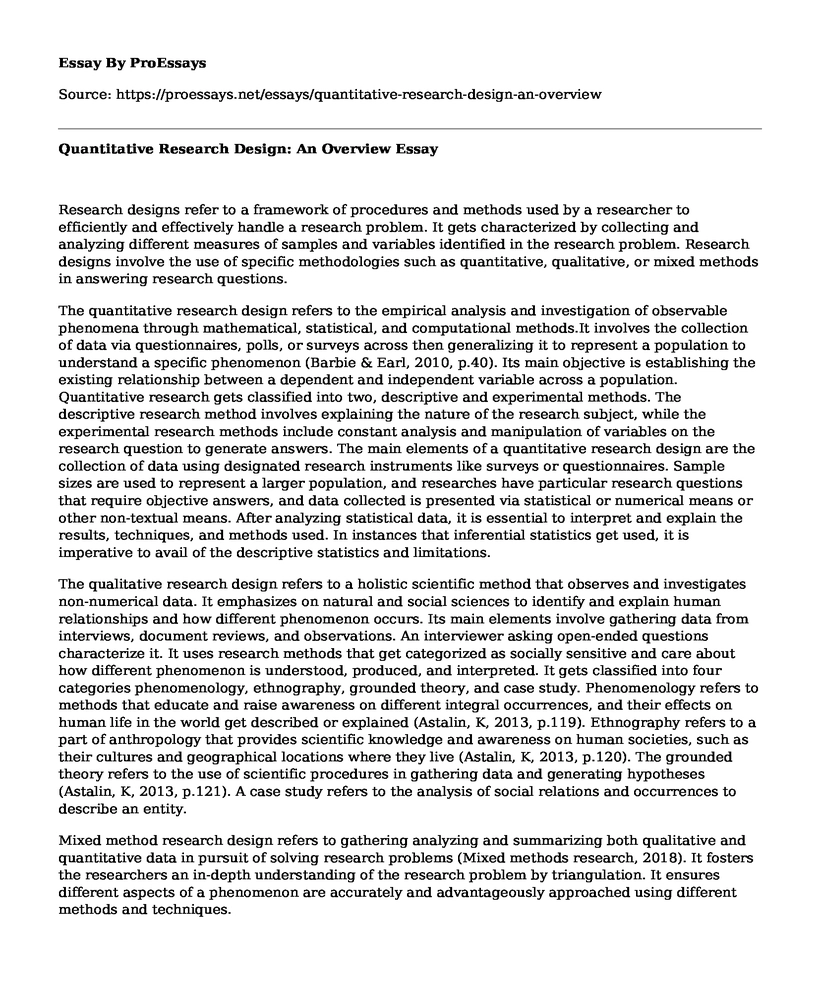Research designs refer to a framework of procedures and methods used by a researcher to efficiently and effectively handle a research problem. It gets characterized by collecting and analyzing different measures of samples and variables identified in the research problem. Research designs involve the use of specific methodologies such as quantitative, qualitative, or mixed methods in answering research questions.
The quantitative research design refers to the empirical analysis and investigation of observable phenomena through mathematical, statistical, and computational methods.It involves the collection of data via questionnaires, polls, or surveys across then generalizing it to represent a population to understand a specific phenomenon (Barbie & Earl, 2010, p.40). Its main objective is establishing the existing relationship between a dependent and independent variable across a population. Quantitative research gets classified into two, descriptive and experimental methods. The descriptive research method involves explaining the nature of the research subject, while the experimental research methods include constant analysis and manipulation of variables on the research question to generate answers. The main elements of a quantitative research design are the collection of data using designated research instruments like surveys or questionnaires. Sample sizes are used to represent a larger population, and researches have particular research questions that require objective answers, and data collected is presented via statistical or numerical means or other non-textual means. After analyzing statistical data, it is essential to interpret and explain the results, techniques, and methods used. In instances that inferential statistics get used, it is imperative to avail of the descriptive statistics and limitations.
The qualitative research design refers to a holistic scientific method that observes and investigates non-numerical data. It emphasizes on natural and social sciences to identify and explain human relationships and how different phenomenon occurs. Its main elements involve gathering data from interviews, document reviews, and observations. An interviewer asking open-ended questions characterize it. It uses research methods that get categorized as socially sensitive and care about how different phenomenon is understood, produced, and interpreted. It gets classified into four categories phenomenology, ethnography, grounded theory, and case study. Phenomenology refers to methods that educate and raise awareness on different integral occurrences, and their effects on human life in the world get described or explained (Astalin, K, 2013, p.119). Ethnography refers to a part of anthropology that provides scientific knowledge and awareness on human societies, such as their cultures and geographical locations where they live (Astalin, K, 2013, p.120). The grounded theory refers to the use of scientific procedures in gathering data and generating hypotheses (Astalin, K, 2013, p.121). A case study refers to the analysis of social relations and occurrences to describe an entity.
Mixed method research design refers to gathering analyzing and summarizing both qualitative and quantitative data in pursuit of solving research problems (Mixed methods research, 2018). It fosters the researchers an in-depth understanding of the research problem by triangulation. It ensures different aspects of a phenomenon are accurately and advantageously approached using different methods and techniques.
Educators are using research findings to foster skill specialization and development in schools. Teachers are creating research questions to determine what skill a student is competent in, collecting and using data to guide students in what and how to nurture specific skills. It, later on, helps students in their future professions and educators gain a better understanding and relation with their students.
In conclusion, research designs are methods used to observe, collect, analyze, and interpret data to solve or answer research questions. Among the three research designs discussed, the most relatable is the quantities of research designs since its objective.It uses numerical data that can get traced back to and uses samples that represent specified populations.
References
Babbie, Earl R. The Practice of Social Research. 12th ed. Belmont, CA: Wadsworth Cengage, 2010; Muijs, Daniel. Doing Quantitative Research in Education with SPSS. 2nd edition. London: SAGE Publications, 2010.
Mixed Methods research. (2018). Mixed methods research.Retrieved from http://resourcecentre.foodrisc.org/mixed-methods-research_185.html.Accessed on 2019 November 28.
Astalin, K. (2013, January 18).Qualitative Research Designs: A conceptual framework. Retrieved from https://pdfs.semanticscholar.org/baa7/c8f5577b0b1798b5e9f559f5cbae32bf1a36.pdf. Accessed on 2019 November 28.
Cite this page
Quantitative Research Design: An Overview. (2023, Mar 11). Retrieved from https://proessays.net/essays/quantitative-research-design-an-overview
If you are the original author of this essay and no longer wish to have it published on the ProEssays website, please click below to request its removal:
- Statistics for the Behavioral Sciences Paper Example
- External Analysis of Ford Motor Company Paper Example
- Essay on Two-Factor Theory: Herzberg's Research and Criticisms
- Paper Example on Qualitative Research: Exploring Different Approaches
- Essay Sample on Employability: The Key to Organizations' Success in a Competitive Landscape
- Free Essay Example on Harley-Davidson: SWOT Analysis of Global Motorcycle Brand
- Emergency Department Performance Scorecard - Free Report Sample







